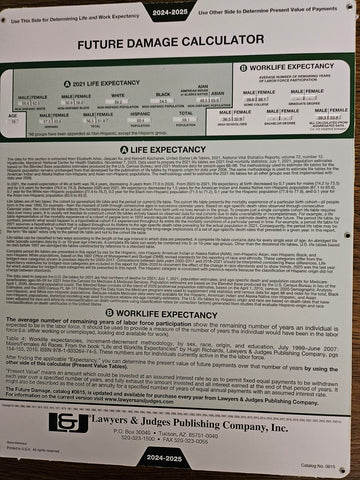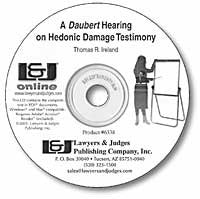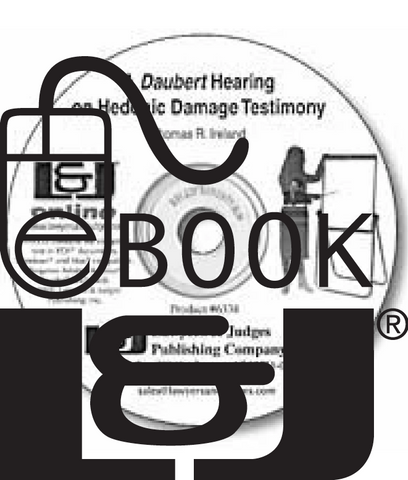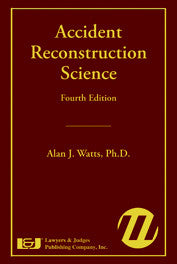
Medical-Legal Aspects of Pain and Suffering PDF eBook
- Author: Patricia W. Iyer; Contributors; Stephen Appelbaum, Carol Anne Bales, Thomas C. Broderick, I. Larry Cohen, Yvonne D'Arcy, Michael D'Lugo, Thomas Duffy, Richard Ford, Suzanne Frederick, Guy Fried, Karen Mandzak Fried, Renee Holleran, Diane Hudson-Barr, Kelly A. Jaszarowski, Sally Lambert, Nancy E. Mooney, Dorene A. O'Hara, John Parisi, Michael A. Pollack, Lisa Stepp, Randall Thomas, Leta Truett, Tom Vesper, J. Michael West
-
ISBN 10: 1930056397
-
ISBN 13: 978-1930056398
-
Copyright Date Ed: May 1, 2003
-
Pages: 525 pages
- PDF eBook
Written for the healthcare professional, claims adjuster and trial attorney, this book provides detailed information on how to analyze pain and suffering cases. You will read chapters written by legal nurse consultants, physicians and attorneys and see how pain and suffering patients and cases are viewed and treated on all sides. Each section of this valuable text is designed to fully explain each aspect of this hot topic in health care.
This book also explains to you how to understand medical records and commonly used pain assessment tools. It focuses on high-risk populations, pain and suffering in children and cancer pain. The last section is dedicated to your presentation of pain and suffering cases in the courtroom.
By combining the clinical information in the first two sections with the legal strategies in the last section, this book becomes a must read for any attorney litigating medical, nursing, or nursing home negligence cases.
Topics include:
- Organization and analysis of medical records
- Pain assessment and management
- Chronic pain cancer
- Spinal cord injury
- Wounds and burns
- Life-care planning
- Chronic pain
- Pain and suffering in children
- Trial exhibits
- Ante-mortem damages
- Defense and plaintiffs' perspectives
- and much more
Table of Contents
List of Illustrations
Preface
Acknowledgments
1. Organization and Analysis of Medical Records
Patricia Iyer, MSN, RN, LNCC
1.1 Introduction
1.2 Documenting Pain and Suffering
1.3 Liability Associated with Failure to Treat Pain Effectively
1.4 Obtaining Medical Records
1.5 Assuring Completeness of Institutional Records
1.6 Organizing and Analyzing Hospital Records
A. Discharge summary
B. Emergency room records
C. Physician orders
D. Physician progress notes and consultations
E. Nurses' documentation
F. Operative records
G. X-rays
H. Laboratory
I. Therapies
1.7 Organizing and Analyzing Rehabilitation Facility Records
1.8 Organizing and Analyzing Nursing Home Records
A. Admission assessment
B. Resident Assessment Protocols
C. Progress notes
D. Nursing notes
E. Therapies
1.9 Organizing and Analyzing Physician Office Records
1.10 Summary
Endnotes
Additional Reading
Additional References by Author
Internet Resources
2. Pain Assessment
Yvonne D'Arcy, MS, CRNP, CNS
2.1 Introduction
2.2 Elements of Pain Assessment
A. Location
B. Intensity
C. Duration
D. Description
E. Aggravating or alleviating factors
F. Functional impairment
G. Case study: Adam
H. Pain goal
2.3 Pain Instruments
A. Case study: Bonita
B. One-dimensional pain instruments
C. Behavioral pain rating scales
D. Multidimensional pain scales
2.4. Assessing Pain in Specialty Populations
2.5 Case Study: Carlos
2.6. Case Study: Diane
2.7. Summary
Endnotes
Additional Reading
3. Pain Management
Dorene A. O'Hara, MD, MSE
3.1 Acute Pain: Introduction
A. Assessment
B. Pain as a signal of injury
C. The neurobiology of pain
3.2 Types of Acute Pain
A. Headache
B. Acute backache
C. Trauma
D. Surgical pain
E. Angina/chest pain
F. Abdominal pain
G. Invasive cancer pain
H. Labor pain
I. Pediatric pain
J. Sickle cell crisis
3.3 Acute Pain: Conclusion
3.4 Acute Pain Cases
3.4. Chronic Pain
A. Assessment
B. Chronic pain syndrome
C. Types of chronic pain
3.5. Treatments for Chronic Pain
A. Medications
B. Local anesthetics and nerve blocks
3.6. Nerve Block Cases
3.7. Cancer Treatments
A. Radiation therapy and implanted pumps
B. Alternative medicine treatments
3.9. Chronic Pain Cases
3.10. Summary of Principles of Chronic Pain Management
Endnotes
4. A Psychologist's View of Pain and Suffering
Lisa Stepp, Ph.D., M.S., R.N., APN, AOCN, CRNH
4.1 Introduction
4.2 The Role of the Psychologist
4.3 Acute Pain
A. Management of acute pain
B. Complications of acute pain
C. Psychological issues in acute pain
4.4 Chronic Pain
A. Impact of chronic pain
B. Suffering in chronic pain
C. Losses in chronic pain
D. Psychological issues in chronic pain
4.5 Common Treatment Problems
A. Malingering and factitious disorder
B. Psychogenic pain
C. Chronic back pain
D. Locked-in syndrome and posttraumatic stress disorder
4.6 Grief
A. Anticipatory grief
B. Grief
C. Complicated grief
D. Additional perspectives on grief
E. The role of the attorney in helping the grieving client
F. Therapy for grief
4.7 Conclusion
Endnotes
Additional Reading
5. Suffering: A Multidimensional Concept
Leta Truett, PhD, RN and Patricia Iyer, MSN, RN, LNCC
5.1 Introduction
5.2 Pain and Suffering Defined
5.3 The Meaning of Suffering
A. Effects of diagnosis
B. Patient perceptions of suffering
C. Defining attributes and characteristics of suffering
5.4 Suffering's Relationship to Quality of Life
A. Physical domain
B. Psychological domain
C. Social domain
D. Spiritual domain
5.5 Assessment Measures
5.6 Documentation of Suffering
5.7 Intervention Approaches
5.8 Role of the Attorney in Evaluating the Effects of Disease or Injury on Quality of Life
A. Physical domain
B. Psychological domain
C. Social domain
D. Spiritual domain
5.9 Legal Implications of Suffering
5.10 Plaintiffs' Attorney's Presentation of Suffering in the Courtroom
5.11 Conclusion
Endnotes
6. Pain and Suffering of Children
Sally A. Lambert, PhD, RN and Diane C. Hudson-Barr, PhD, RN
6.1 Introduction
6.2 Historical Perspective
A. Early History
B. 1900s to present
6.3 Consequences of Pain in Children
6.4 The Developing Child and Understanding of Illness and Pain
A. Premature infants
B. Birth to two years of age
C. Preschool and early school-age
D. School-age
E. Adolescence
F. Summary
6.5 Pain Assessment
A. General assessment guidelines
B. Pain assessment: Observation method (preverbal and nonverbal children)
C. Pain assessment: Children's self-report pain measurements
6.6 Management of Pain
A. Pharmacological pain treatment
B. Non-pharmacological pain treatment
C. Summary
6.7 Plaintiffs' Attorney's Perspective on Pediatric Pain and Suffering
A. Walk a mile in the child's shoes
B. Counter the parents' and treating doctors' optimism
C. Discuss damages in your opening statement
D. Present damages witnesses first
E. Let the evidence speak for itself
6.8 Conclusions
Endnotes
7. Pain and Suffering in Pediatric Neurology
Michael A. Pollack, MD, Michael R. D'Lugo, Esq., and Richard H. Ford, Esq.
7.1 Introduction
7.2 Cerebral Palsy
A. Definitions
B. Incidence
C. Causes
D. Mental retardation, epilepsy, and cerebral palsy
E. Diagnosis
F. Management and prognosis
7.3 Pain and Suffering Associated with Cerebral Palsy
A. Medical issues
B. Social issues
C. School and work
D. Quality of life for children with cerebral palsy
7.4 Representative Cerebral Palsy Cases
A. Amy: Premature infant
B. Bruce: Diagnosis of CP at eighteen months
C. The legal perspective
7.5 Pediatric Head Trauma and Posttraumatic Epilepsy
A. Definitions and incidence
B. Diagnosis and management
C. Surgical management
D. Medical management and rehabilitation
E. Posttraumatic seizures and epilepsy
7.6 Pain and Suffering after Head Trauma
A. Medical issues
B. Social issues
C. School and work
D. Post-concussion syndrome
E. Quality of life in posttraumatic epilepsy
F. Quality of life after traumatic brain injury without epilepsy
G. Quality of life after minor head injury
7.7 Representative Head Injury Cases
A. Carl: Motor vehicle accident
B. Donna: All terrain vehicle accident
C. Eduardo: Abused
D. The legal perspective
7.8 Brachial Palsy
A. Definition
B. Associated problems
C. Incidence
D. Causes
E. Diagnosis
F. Prognosis and management
G. Surgery
7.9 Pain and Suffering in Brachial Palsy
A. Medical issues
B. Social issues
C. School and work
D. Quality of life in obstetric brachial palsy
7.10 Representative Brachial Plexus Cases
A. Fran: Large newborn with difficult delivery
B. Geoffrey: Improvement with surgical treatment
C. The legal perspective
7.11 Conclusion
Endnotes
Additional Reading
8. Pain and Suffering in Emergency Care
Renee Holleran, PhD, RN, CEN, CCRN, CFRN
8.1 Introduction
8.2 Location of Emergency Care
8.3 Prehospital Emergency Care
A. Prehospital care providers
B. Prehospital care environment
C. Patient management in prehospital care
8.4 The Emergency Department
8.5 Pain and Pain Management in the Emergency Department
A. Sources of pain and suffering in emergency care
B. Resuscitation
C. Emotional pain and suffering
8.6 Management of Pain and Suffering in Emergency Care
8.7 Summary
Endnotes
9. Spinal Cord Injury
Guy William Fried, MD and Karen Mandzak Fried, MSN, RN, CRRN, CCM
9.1 Introduction
A. Incidence and etiology
B. Classification of injuries
9.2 Immediate Care
A. Spinal stabilization
B. Spinal shock
9.3 Long-Term Effects of Spinal Cord Injury
A. Respiratory changes
B. Cardiovascular changes
C. Skin changes
D. Bowel, bladder, and sexual changes
E. Bone changes
F. Neurological changes
G. Pain
H. Psychosocial and emotional changes
9.4 Survival and Prognosis
Endnotes
10. Pain and Suffering in Orthopaedics
Nancy E. Mooney, MA, RN, ONC
10.1 Introduction
10.2 Causes of Orthopaedic Pain
10.3 Assessment of Neurovascular Status
10.4 Fractures
A. Why does a fracture hurt?
B. Fracture healing
10.5 Modalities of Immobilization
A. Casts
B. Cast brace
C. Traction
D. External fixation
10.6 Complications
A. Bone union problems
B. Cast syndrome
C. Limb length discrepancies
D. Osteomyelitis
E. Foot drop
10.7 Hip Fractures
A. Risks
B. Fat embolism syndrome (FIS)
C. Pulmonary embolism (PE)
D. Deep vein thrombosis (DVT)
10.8 Revised Total Arthroplasty
10.9 Summary
Endnotes
Internet Resources
Orthopaedic Websites
11. Cancer Pain and Suffering
Carol Bales, MSN, RN, AOCN, CCRP
11.1 Introduction
11.2 Cancer Defined
11.3 Pain Defined
11.4 Oncological Terminology
11.5 Cancer Diagnosis and Prognosis
11.6 Survival Rates and Other Epidemiological Terminology
11.7 Breaking the News
11.8 Diagnostic Period Anxiety
11.9 Dealing with the Diagnosis
11.10 Cancer Care Team Support of Newly Diagnosed Patients
11.11 Framing the Cancer Patient's Experience of Pain and Suffering
11.12 Pain: A Subjective Symptom versus an Objective Clinical Sign
11.13 Individual and Cultural Perceptions Related to Cancer
A. Sex differences
B. Inadequate pain management
11.14 Psychoneuroimmunology and Pain
11.15 Suffering
A. General stress related to cancer diagnosis
B. Impact of the diagnosis on family
C. Fear of stigmatization
D. Misdiagnosis and delayed diagnosis
E. Anxiety as a manifestation of suffering
F. Depression and depression assessment
G. Isolation and loneliness
H. Aggravation of existing psychological symptoms and conditions
I. Helplessness
J. Suffering of and caused by family and significant others
11.16. Suffering Caused by Symptoms of Cancer or its Treatment
A. Shortness of breath
B. Suffering related to oncological emergencies
C. Central nervous system conditions caused by cancer metastasis or treatment
D. Cancer fatigue
E. Suffering caused by chemotherapy, radiation therapy, and surgery
11.17 Fragmentation of Support Services
A. Need for advocacy
B. Need for support groups
11.18 Legal Considerations
11.19 Summary
Endnotes
Additional Reading
12. Wounds and Burns
Kelly Jaszarowski, MSN, RN, CNS, ANP, CWOCN
12.1 Introduction
12.2 Wound Characteristics
A. Etiology
B. Physiology of wound healing
C. Management principles
D. Methods of treatment
E. Physiological rationale for pain
12.3 Life with a Wound
12.4 Burns
A. Etiology
B. Treatment modalities
C. Physiological rationale for pain
12.5. Life with a Burn
Endnotes
13. Ostomies and Incontinence
Kelly Jaszarowski, MSN, RN, CNS, ANP, CWOCN
13.1 Introduction
13.2 Ostomies
A. Gastrointestinal ostomies
B. Genitourinary ostomies
C. Methods of treatment
D. Physiology of pain
13.3. Life with an Ostomy
13.4 Continence
A. Urinary incontinence
B. Fecal incontinence
13.5. Life with Incontinence
13.6 Applying the Knowledge
A. Ostomy-related litigation
B. Incontinence-related litigation
13.7 Conclusion
Glossary
Endnotes
14. Pain and Suffering in the Intensive Care Unit
Ian Larry Cohen, MD, FCCP, FCCM
14.1 Introduction
14.2 Understanding the ICU
A. What is an intensive care unit?
B. What is a critically ill patient?
C. Physical layout of an ICU
D. Personnel involved in ICU care
E. Organizational aspects of the ICU
F. Patient population characteristics
G. Technology--mechanical ventilation
H. Other technologies used in ICU
I. Procedures performed in the ICU
J. Drugs used in the ICU
K. Standardized measurements of pain and suffering
14.3 Stressors in the ICU--Causes of Pain and Suffering
A. Environment
B. Equipment and alarms
C. Severity of illness
D. Procedures and routine care
E. Tubes, catheters, and attached devices
F. Recall
G. Pain
H. Anxiety and fear
I. Delirium and psychosis
J. Sleep deprivation and sleep disturbance
K. Restraints
L. Loss of control
M. Family
N. Staff
O. Drug and alcohol withdrawal
P. Drug reactions
14.4 Consequences of Stress
A. Agitation
B. Organ dysfunction and organ failure
C. Infection, bleeding, strokes, heart attacks, heart rhythm disturbances, and pulmonary embolism (blood clots to the lungs)
D. Drug addiction and drug withdrawal
E. Prolonged disability and critical care polyneuropathy
F. Depression and posttraumatic stress disorder (PTSD)
G. Death
H. Staff burn out and family distress
14.5 Summary
Additional Readings
Internet Resources
Additional References by Author
15. Pain and Suffering in the Elderly Population
Suzanne Frederick, MSN, RN
15. Introduction
15.2 Causes of Chronic Pain in the Elderly
15.3 Pain Assessment and the Undertreatment of Pain in the Elderly
15.4 Pain in the Cognitively Impaired Older Person
A. Misconception that individuals with dementia do not feel pain
B. Ways of assessing pain in the cognitively impaired elderly
15.5 Consequences of Pain
15.6 Suffering
15.7 Documentation of Pain in the Medical Record
15.8 Pain and Suffering Associated with Pressure Ulcers
15.9 Pain and Suffering Associated with Fractured Hip
15.10 Pain and Suffering Associated with Abuse and Neglect
15.11 Pain Management Principles in the Elderly
15.12 Summary
Endnotes
Additional Reading
16. Life Care Planning and Chronic Pain
Randall Thomas, PhD, CRC, NCC
16.1 The Field of Life Care Planning
A. Background
B. Definition
C. Practitioners in the field of life care planning
D. Limitations of the life care planner role
E. How items are selected and costed in a LCP
16.2 Chronic Pain
16.3 Life Care Plan Areas and Items Related to Chronic Pain
A. Projected evaluations
B. Projected therapeutic modalities
C. Diagnostic testing and educational assessment
D. Wheelchair (mobility), wheelchair accessories and maintenance
E. Aids for independent function
F. Durable medical equipment
G. Prosthetics and orthotics
H. Supplies
I. Medications
J. Home care and facility care
K. Medical care--Routine
L. Acute medical intervention--Surgical
M. Health and strength maintenance
N. Transportation
O. Architectural renovations
P. Vocational and educational plan
Q. Potential complications
16.4 Conclusion
Endnotes
Appendix: Example of Life Care Plan for an Individual with Chronic Pain
17. The Expert Fact Witness
Patricia Iyer, MSN, RN, LNCC
17.1 Introduction
17.2 Pain and Suffering Testimony
A. Legal basis
B. Use of pain and suffering summaries
C. Procedural pain
D. Suctioning
E. Assessment of level of consciousness and infliction of pain
F. Cases
17.3 Format for the Pain and Suffering Report
A. Cover and table of contents
B. Introduction and description of the accident
C. Evaluation and description of injuries in the emergency department
D. Treatment in the emergency department
E. Chronological summary of status and problems
F. Presentation of major problems
G. Description of problems divided into categories
H. Evidence of emotional reactions
I. Level of awareness
J. Pain
K. Summary of status at key times
L. Description of death
M. Summary paragraph
17.4 Overcoming Motions to Prevent Expert Fact Witness Testimony
A. Objection: Use of treating healthcare workers
B. Objection: Repetitive with the plaintiff's testimony
C. Objection: There are only two types of witnesses: Fact witnesses and expert witnesses
D. Objection: Jury can read records
E. Objection: Use expert witnesses to present information
F. Objection: Prejudicial nature of the testimony will outweigh the probative value
17.4 Summary
Endnotes
Additional Reading
Appendix: Hypothetical Argument Supporting Qualification of Expert Fact Witness
18. Trial Exhibits:Legal and Strategic Considerations
Patricia Iyer, MSN, RN, LNCC, Stephen Appelbaum, CEP, EPIC, and John M. Parisi, Esq.
18.1. Introduction
18.2. Types of Trial Exhibits
A. Real evidence
B. Demonstrative evidence
C. Visual aids
18.3. Purposes of Trial Exhibits
A. Preservation and presentation
B. Burden of proof
C. Persuasion
D. Use of primacy and recency for persuasion
E. Aristotle's principles of persuasion
F. Engage the senses
18.4. Evidentiary Considerations
A. Relevance
B. Authentication
C. Materiality
D. Unfair prejudice
E. Hearsay
F. Exceptions to hearsay
18.5. Considerations in Selecting Courtroom Demonstrative Evidence
A. Planning
B. Effect
C. Comfort level
D. Mark and agree on exhibits with the adversary before trial
18.6 The Plaintiff in the Courtroom
18.7. The Remote Witness in the Courtroom
18.8 Use of Demonstrative Evidence When Asking for Money
18.9 Jury Instructions on Pain and Suffering
18.10 Conclusion
Endnotes
19. Trial Exhibits: Preparation and Use
Patricia Iyer, MSN, RN, LNCC, Stephen Appelbaum, CEP, EPIC, and John Parisi, Esq.
19.1 Introduction
19.2 Types of Exhibits
A. Patient diaries
B. Photography
C. Videotape
D. Radiology and diagnostics
E. Medical records
F. Graphics
G. Anatomical models
H. Medical illustrations
I. Medical equipment
J. Pain medications
K. Computer animations
19.3 Design Principles
A. Comprehension
B. Color
C. Time frames
D. Fonts and design
E. Considerations for older jurors
F. Revisions
19.4. Overview of Presentation Systems
A. Paper system
B. Optical (transparency) projector and screen systems
C. Electronic projectors and visual presenters
D. Digital system
19.5 Summary
Endnotes
Additional Reading
Sources of PowerPoint
Templates, Images and Tips
Sites for Improving Presentation Skills
20. Ante-Mortem Damages
Tom Vesper, Esq.
20.1. Introduction to Conscious Pain and Suffering in Wrongful Death Cases: A Sensitive but Necessary Subject
20.2 Before Death (Ante-Mortem) Distress, Fear, and Anxiety
20.3. Loss of Enjoyment of Life and the Unconscious Comatose Victim
20.4 Facts and Circumstances Proving Ante-Mortem Damages
A. Eyewitness testimony
B. Expert witnesses
C. Pre-impact warnings
D. Nature of incident
E. Internal injuries or evidence consistent with pain
F. Painfully obvious external injuries
G. Mechanism of injury
H. Cause and manner of death
I. Express declarations of pain
J. Any communication
K. Attempts to communicate
L. Attempts to escape or avoid impact or injury
M. Signs of evacuation
N. Cooperation
O. Response to stimuli
P. Facial expressions
Q. Movement
R. Difficulty breathing
S. Involuntary expressions of pain
T. Involuntary physiological changes
20.5. The Usual Defensive Positions or Arguments
A. Instantaneous death
B. Finding fault with eyewitness observations
C. Involuntary or voluntary movements
D. The battle of the experts
E. Shock
F. Analgesia: Alcohol, drugs, or other pain relief
20.6 The Usual Suspects or Witnesses to the Final Agony
20.7 Obtaining the Statements of Witnesses
20.8 Sources of Witnesses
20.9. Use of a Forensic Pathologist
20.10 Conclusion
Endnotes
Additional Reading
Additional Readings by Author
21. A Defense Attorney's Perspective
J. Michael West, Esq. and Thomas C. Broderick, Esq.
21. 1 Introduction
21.2 Categories of Pain and Suffering Claims
A. Exaggeration
B. Severe and permanent damages
C. Malingering
21.3 Malingering in Pain and Suffering Claims
A. Definitions
B. Implications of malingering in the legal system
C. Independent medical examinations or retained physician examinations
D. Use of psychiatrists
E. Comprehensive record review
F. Testing
G. Clinical indicators of malingering
H. Relevant literature
21.4 Defense Attorney's Strategic Use of Suspicions of Malingering Behavior
A. The first rule: Assume malingering
B. Juror reactions to malingering
C. The second rule: Assume your case will go to trial
D. Medical professionals and malingering
21.5 Evidentiary Concerns Related to Malingering
21.6 Pain and Suffering Damages--Pretrial Considerations
A. Law of intangible damages
B. Physician's role
C. Investigation and discovery
D. Experts
E. Settlement negotiations
F. Using mediators to address unreasonable expectations for pain and suffering damage awards
G. Mock trials and mock jurors
21.7 Damages for Pain and Suffering
A. Pretrial checklist
B. Jury selection
C. Opening statements
D. Evidence
E. Closing arguments
F. Jury instructions and closing arguments
21.8 Conclusion
Endnotes
Additional Reading
22. A Plaintiffs' Attorney's Perspective
Thomas Duffy, Esq.
22.1 Introduction
22.2 What Is Pain and Suffering?
22.3. Initial Interview
22.4. Initial Review
22.5. Early Documentation
22.6. Following the Client's Progress
22.7. Responding to Written Discovery
22.8. Preparation for Deposition
22.9. Final Preparation for Trial
A. Demonstrative evidence
B. Selection of witnesses
C. Preparing witnesses for trial
22.10. Opening Statement
22.11. Presentation of Evidence
22.12. The Closing Argument
Endnotes
Additional Reading
About the Editor
About the Authors
Index




